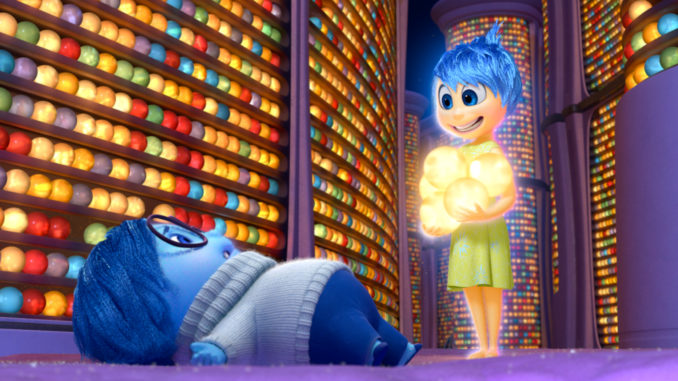
Inside Out is a Disney-Pixar animated film which successfully uses graphics and humor to show what is going on inside someone's head. This promises to be an entertaining way to teach emotional intelligence.
General scenario of Inside Out
Growing up can be a difficult time. This is true for 11-year-old Riley. Her father starts a new job on the West Coast and so she is uprooted from her life in Minnesota when the family moves to San Francisco.
Riley's mind is portrayed by five small characters called Joy, Fear, Disgust, Sadness and Anger. These are personified in the film as human-like creatures who live in Headquarters. This is the headquarters of Riley's head where executive decisions take place. She responds to events according to which little figure is taking charge.
The emotional characters in Inside Out
- Joy is a light-hearted optimist trying to ensure Riley is happy.
- Fear is awake to any hazards and is concerned to keep Riley safe.
- Disgust wants to show Riley what physically and socially poisons her.
- Sadness dwells on the unhappy side of things.
- Anger cares a lot about protesting when things are unfair.
As Riley's emotions struggle to adjust to her new life, chaos ensues in Headquarters.
Portrayal of core memories in Inside Out
Riley's past experiences are stacked as core memory balls in long-term storage. Each of these can be called on but sometimes they get dumped and lost. The memories are colored and distorted if touched by one of the emotion characters. For example, an experience is remembered differently by being turned blue if touched by Sadness.
The view of Inside Out regarding the causes of behavior
Inside Out suggests that the emotional figures can make Riley feel what they want according to which of them is in charge of the controls and which can touch a core memory. Children need to learn to recognize how emotions affect the way we all behave and learn to put names to them. In addition, there is the useful point that we can misremember the past according to our current feelings.
Riley is shown to be a victim of her emotions. She appears to have no choices. According to Inside Out, it is the specific situation one finds oneself in that determines one's emotional response. What emotional attitude we adopt comes from experiences in life or rather the way these are remembered. In line with the story of Inside Out, core memories can be colored by which emotion currently in charge touches them.
An alternative view to that conveyed by Inside Out
In my opinion the film omits the important dimension of personal choice. Perhaps this was necessary because of the simple nature of the plot. Is Riley to be thought of as a mere robot just responding to which emotion is the strongest at any one particular moment? A different view is that we ourselves are in charge of which emotion rules us. According to this standpoint, each person has volition (free-will). In other words, we can make personal choices which can go beyond what might be expected from experience and current adversity.
Did Riley have to snap back at her parents when they tried to talk to her after her unhappy day at the new school? Did anger have to be in charge?
Was there no other response available to her other than to abruptly end the phone call from the old friend? She had been told there is a new girl on her old team who played really well with Meg. Did social disgust have to rule her mind at that point?
Had she no choice other than to roll over and face the wall after Dad tries to cheer her up by acting goofy? Did sadness really make her do this?
Rational thoughts
Just as our core memories can be colored by our emotions, so can our thoughts. I feel afraid so I am likely to think about dangers around me. However, it also works the other way around. My thoughts can affect my feelings. So if I reflect on my situation and think about it from a wider perspective, I may feel differently. For this reason, I believe our natural passions need not dominate us.
Riley is only a child, and her responses to what happened to her are perhaps only what we might expect from a child. As an adult she might look back and think that when her parents tried to talk with her perhaps she could have discussed the reasons for the house move instead of snapping at them thus ending the conversation.
When Meg spoke about a new friend, perhaps Riley could have thought about the new friends she might expect to make in her new school and talked with Meg about their keeping contact instead of rudely ending the call.
In addition, when her father tried to make up with her by acting goofy perhaps she might have thought about making the best of her new circumstances and get his help to do this instead of turning away from him.
Learning to relate to people is not just about recognizing emotions that they and we feel. I would say it is also about learning reflection and self-control. Should children be learning this also?
" What is truly human about us is our rationality, our ability to see and know, if we try, what is true and what is good, and also our ability freely to intend, think, say, and do it " (Emanuel Swedenborg, spiritual philosopher)
Proudly WWW.PONIREVO.COM
Source by Stephen Russell-Lacy



